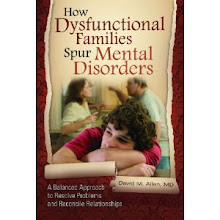There are currently hundreds of different “schools” of psychotherapy, each with their own theories to account for problematic behavioral, relationships, and thought patterns in individuals. Most of them are variations on the six major schools of thought in the field: psychodynamic, cognitive, behavioral, affect-focused, existential, and family systems. Still, they often have completely different ideas about what is important to focus on in psychotherapy, as well as the reasons for their clients' problems.
In 1985, the Milton Erikson Foundation put on the first of several "Evolution of Psychotherapy" Conferences, in which they were somehow able to get all the current head honchos of the various schools (pictured above). I was there and it was impressive to hear them present their ideas and argue with one another. Before I even became an academic and while in private practice, I had done extensive reading and noticed that each of these differing, very complex schools of thought had valuable things to say about human nature, but that each was riddled with some logical fallacies as well as outright distortions. I decided to attempt to write a book on what I called a "unified theory," which I somehow managed to get published in 1988.
So why so many schools of thought? In a way, this plethora of theories and methodology is not at all surprising in light of the fact that psychology is still a relatively young science, and having several theories is typical of new scientific endeavors. In the case of psychology, coming together is particularly difficult because of the sheer number and magnitude of natural processes involved, coupled with the fact that we cannot read minds. When it comes to important phenomena such as domestic violence and child abuse, people lie all the time – not only to others but to themselves as well. They do so out of shame or a desire to protect other family members.
So-called “empirical” studies in the field are, in a sense, collections of anecdotes: the impression of the researcher coupled with the self report of the individuals being studied. To really know with any certainty what is going on with, say, family interactions , experimenters would have to be able to watch them, over a significant period of time when people were not aware they are being watched. This cannot be done to the extent necessary.
The problems in the field are further made difficult to sort out due to the complex structure of the human brain as well as the sheer number of environmental factors which impinge on it. The brain has billions of neurons, each with up to about 1000 constantly changing synaptic connections caused by a process called neural plasticity. These connections are further impacted by scores of different genes, which do not determine human behaviors but each making certain behavioral tendencies a little stronger or a little weaker.
Relevant environmental influences probably number in the hundreds and come and go in various and constantly changing combinations and intensities. Then there is the so-called “butterfly effect” in which even small differences in initial conditions lead to major differences later on.
Finally, the complexity of the problems that bring clients to therapy varies widely depending on their specific issues. Some problems are rather straightforward like simple phobias or lack of assertiveness with strangers. Others involved horrendous issues such as a family violence or substance abuse and their ongoing effects. One-size-fits-all interventions such as cataloguing irrational cognitions do not really seem adequate for comprehensive treatment.
Treatment outcome studies have been little help. Generally, all the major treatments come out about the same in terms of efficacy. People in SEPI, a professional group that looked at these issues, used to jokingly refer to this as the “Dodo Bird” (from Alice in Wonderland) verdict: All have won and all must have prizes. Even then, a significant percentage of subjects do not respond that well, and those that do improve often the improvement does not last for more than a year. When one paradigm is directly compared with another in a study for a given condition, 85% of the time the treatment favored by the person designing the experiment "wins" and outperforms the other treatment. This is most likely to something called the “allegiance effect.” Another issue: sometimes acceptance of an idea in the field is due to the eminence of the experimenter and not due to the actual evidence.
It seems to me that many of
these schools of thought assume without real evidence that all the problems of
people who are repeatedly self-defeating or self destructive, or who make
choices in life that make them unhappy, do so because they are mentally deficient
in some way. I have categorized these alleged deficiencies as their being either “mad, bad, or
stupid.” That is, insane, evil, or unintelligent. Non-psychotic clients are usually are none of
these things.
Furthermore, as described in a previous post, psychological problems are often seen by
practitioners and theoreticians alike as existing only in people’s heads, as if
the client’s current social and relationship environment is almost irrelevant. For example, in studies of the alleged
over-reactiveness of people diagnosed with so-called borderline personality
disorder, subjects keep diaries of when they have strong emotional reactions –
“ecological momentary assessment” – but are not asked to also write down what
it is they are reacting to.
In the 1980’s and 1990’s, family systems schools began
to address this deficiencies – but then they went to the opposite extreme by
viewing clients entirely as pawns of their kin groups with no capacity for
critical thinking and independent decision making.
Psychiatry, in the meantime, has swung back and
forth between, as L. Eisenberg put it back in 1986, brainlessness (Freudian
psychoanalysis, for example) and mindlessness (eugenics in the 1930’s and the
over-estimation of biological psychiatry in the present).
There are a few of use who are still trying to put all these various ideas together in some sort of valid and coherent form. Gaining acceptance by the field for these efforts is an uphill battle.
















